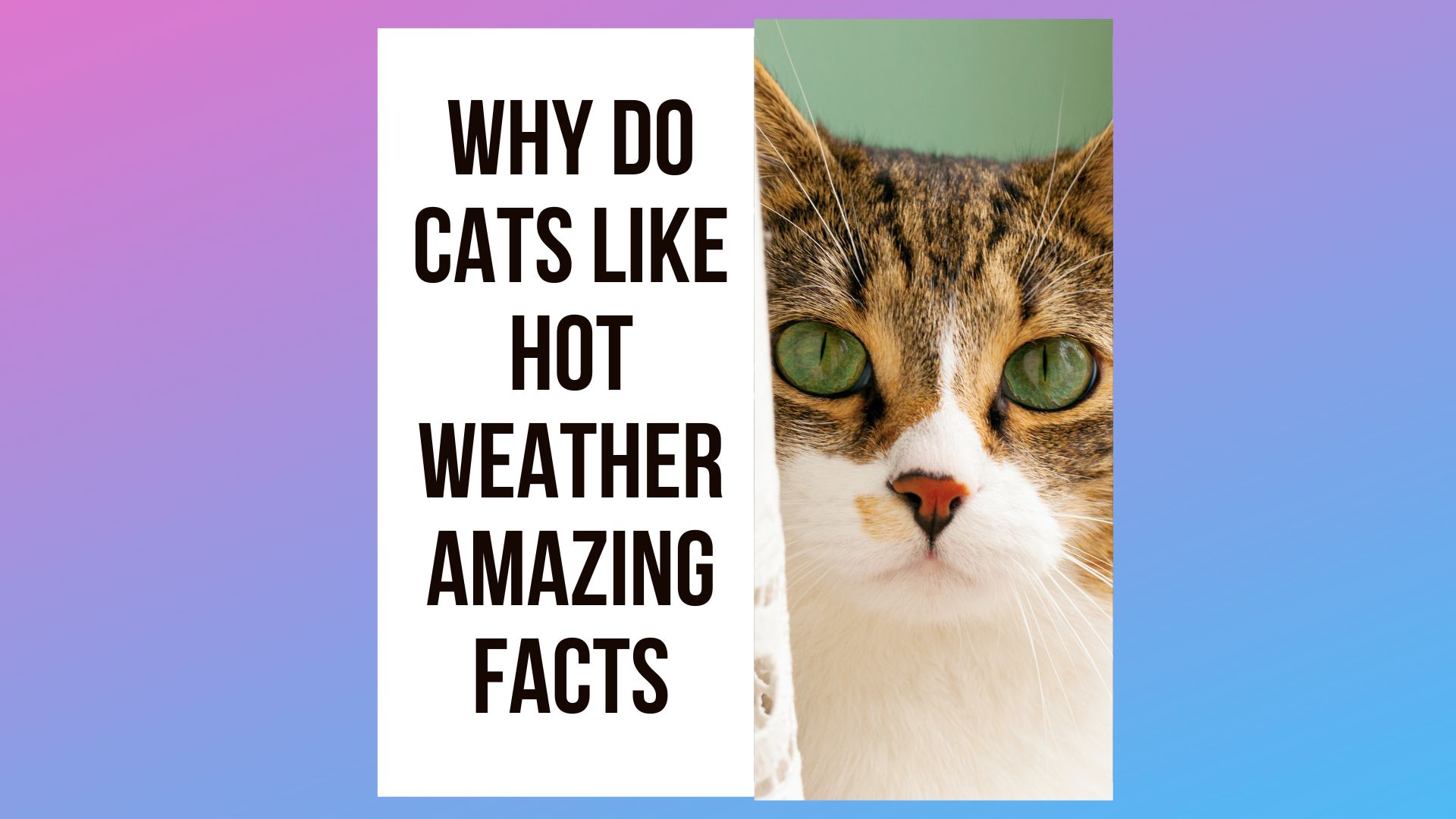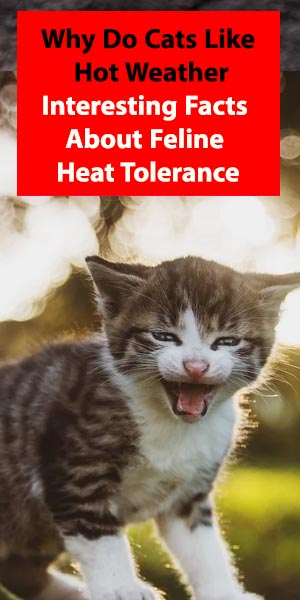
Cats seem to be able to tolerate heat in a way that their humans often cannot. Even as you are running indoors for the air conditioning and a cool drink, your cat is laying flat out on hot asphalt soaking up the rays.
What on earth is going on?
There are some key reasons why cats are better able to tolerate heat than most people. But this is not to say that all cat breeds tolerate heat equally well, either. It is still important to protect your cat when it is very hot outside!
In this article, learn why most cats like hot weather and some safety tips to make sure it doesn’t get too hot for your outdoor cat.
Why Do Cats Like Hot Weather?
In general, cats like warmer weather because they do not feel the heat in the same way that people do.
Very young kittens in particular crave warmth because when a kitten is born, they haven’t yet developed a way to self-regulate their own body temperature. So if the mother cat doesn’t warm them, the kittens can die.
But some cat breeds are more heat-tolerant than others, so it is important not to assume it is never “too warm” for your cat!
Learn How to Protect a Cat in Hot Weather
This short, helpful YouTube video gives you five key tips to protect your cat from excessive heat whether they are indoors or outside.
In particular, the video points out that cats can actually get sunburn just like people do, especially if they have short or sparse coats.
Before assuming your cat is doing fine outside on a very hot day, it can help to take some precautions as the video suggests.
Why Cats Tolerate Heat Better Than People Do
There are some species-specific reasons why cats in general tolerate heat better than humans.
Cats have a higher natural body temperature than people do
The first reason is that cats have a higher internal thermostat setting than do people.
As Pet WebMD explains, while most people have a body temperature right around 98.6 degrees Fahrenheit, most cats have a body temperature of between 100.4 and 102.5 degrees Fahrenheit.
So when it already feels really hot to you, things are only just starting to warm up for your kitty.
Cats do not have as many ways to sense heat as people do
As Cat Ranch Rescue charity explains, cats don’t have as many heat sensors in their bodies as you do.
However, according to the Washington Post, felines are homeotherms, which means they are able to self-regulate their own internal body temperature – most of the time.
If a cat’s natural temperature set point is between 100.4 and 102.5 degrees Fahrenheit, any temperature higher than 102.5 degrees Fahrenheit signals the start of the fever.
When a cat’s internal body temperature reaches 106 degrees Fahrenheit, this is life-threatening, as Fetch by WebMD highlights.
Most cats have the extra heat protection from their fur
Oddly, a cat’s fur can actually help repel the heat, which is especially important to know since cats don’t sweat through their skin as people do.
This means that cats with sparse coats, hairless cats, or cats that have been shaved are at far greater risk of heatstroke and overheating than are cats with fur.
Unique Ways That Your Cat Stays Cool in Hot Weather
When air conditioning was invented, people stopped worrying about the heat so much.
But your cat has had to develop their own way of staying cool.
In order for a cat to cool down when it gets very hot, they have to be able to lower the temperature of their blood. There are four main ways cats do this.
1. Conduction
Conduction is a scientific principle that states that heat will dissipate naturally when it comes in contact with a source of cool.
So for example, if your cat is laying outside in the sun and gets very hot, you may see your kitty get up and walk to a cooler area and lay down there.
This activates convection. The cooler surface begins to draw heat away from the cat and towards the cooler surface, accomplishing a lowering of the cat’s internal thermostat.
2. Convection
Convection is a scientific principle that states that heat will actively transfer when it comes into direct contact with cold.
An example of this would be if your cat decided to swim in a cold pool or drink cold water or stand in front of a cold fan.
While many cats seem to have an aversion to fans and swimming, some cats enjoy both. And most cats will readily appreciate some cold water to drink.
3. Panting and sweating
The third way that cats keep themselves cool in hot weather is by panting and sweating.
However, because cats have very limited sweat glands that are located only in their paw pads and near their anus, this is not a very effective method of cooling down the blood.
4. Self-grooming
Yet another way that cats keep themselves cool in very hot weather is self-grooming – licking their fur.
This transfers a bit of moisture to the fur that evaporates, drawing away some heat with it.
Warning Signs Your Cat Is Suffering from Overheating
As Barn Cat Lady rescue explains, cats can and do suffer from overheating and heat stroke, which can quickly turn fatal.
It is important to not assume your cat is so smart they will automatically sense when they are dangerously close to overheating.
This is especially true for young kittens and senior cats who may be less quick to sense they are in danger.
Here are some of the most commonly reported warning signs that your cat needs your help to cool down.
- Panting.
- Lethargy.
- Their eyes are sunken.
- Elevated heart rate.
- Dehydration (no or little urine output).
- Paw pads feel clammy.
- Saliva is thick or sticky.
- Drooling.
- Their gums and mouth are bright red.
- Vomiting.
- Dizziness and disorientation.
- The temperature of 105 degrees Fahrenheit or higher.
- Seizures.
- Coma.
If you see any of these warning signs your cat’s situation has already become urgent.

How to Help Your Cat Avoid Overheating
If you are caring for an outdoor-only cat, you likely already know full well that your cat isn’t going to come indoors just because it gets hot.
But there are some ways to make hot temperatures easier on your cat and reduce the risk of a feline heat stroke situation.
Provide a “shade station” outdoors
Providing some shade over your cat’s favorite lounging area outside can help encourage your cat to move into the shady area nearby when it is the hottest part of the day.
Install a moving water fountain
Your cat will probably drink more if the water is moving since many cats are attracted to moving water.
Add some ice cubes to the water
You can freeze some chicken or tuna broth into ice cutes to add to the water to further encourage more drinking.
Do not shave or drastically trim your cat’s coat
As you learned earlier here, your cat uses its fur as a cooling mechanism. This is why you don’t want to shave or clip the coat too close, which could cause overheating and sunburn.
Offer wet or moist food
Sometimes no matter what you try your cat may still refuse to drink water. This is because cats have evolved to take in the moisture they need from eating live prey.
You can make up some of the difference by switching to wet or moist food, even if you have to add some broth or water to your cat’s normal kibble.
Board up any outdoor structures where heat could build-up
If you have a storage shed, greenhouse, barn, or garage where your cat likes to go, these are areas where temperatures can soar in summer. You want to try to keep your cat out of them to avoid overheating.
Mist your cat with cool water
While cats are famous for disliking water, not all cats actually do avoid getting wet. And most cats appreciate a cooling mist when it gets hot as this helps heat evaporate from their coat.
Now you understand why cats like hot weather. But you also know that cats are not immune to overheating, heat exhaustion, heatstroke, sunburn, and skin burns.
There is no doubt it is easier to keep an indoor cat safe during the hot season, but you can also do a lot to make the dog days of summer less stressful and dangerous for an outdoor cat.
Never hesitate to bring your cat to the veterinarian if you see any signs of overheating!
For Further Reading

Hi, This is Alexa, and I love cats. This Website is a Complete Journal about how to travel with a cat and other information about Cat Health, Cat Training, Cat Behavior, Cat Foods and more. I hope you find it useful.
